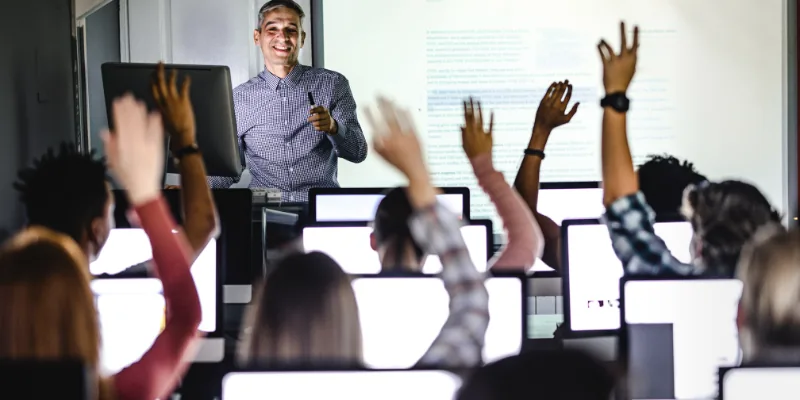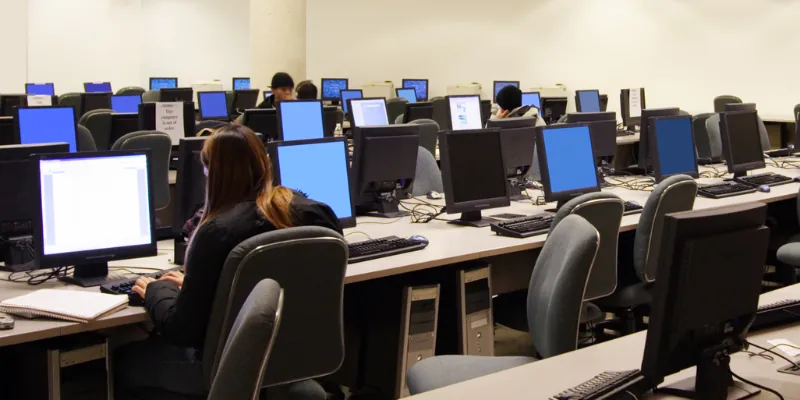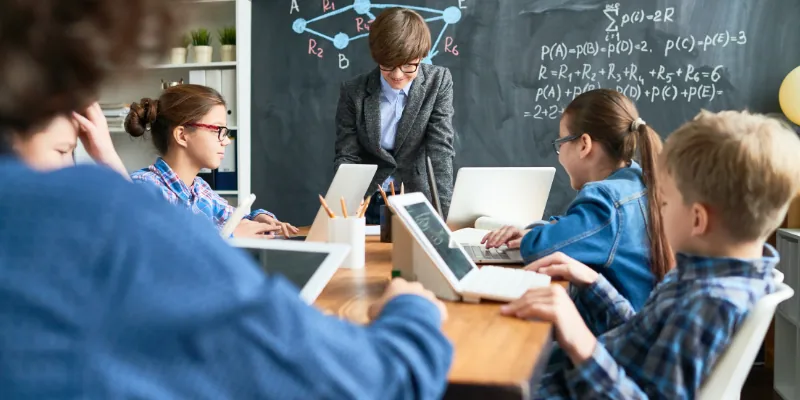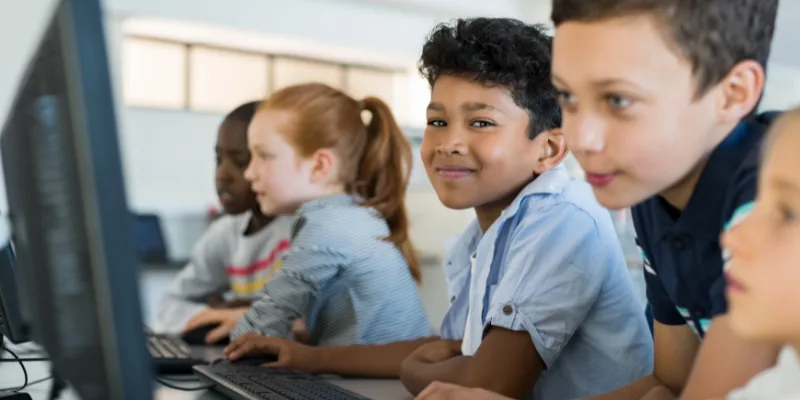Advantages of Computer in Education for Learning Growth
Published: 16 Feb 2025
Did you know that over 90% of schools worldwide now use computers for teaching? Education has changed dramatically over the past few decades, and technology plays a key role in this transformation. Today, students no longer rely only on textbooks and blackboards. Instead, they have access to digital learning tools, educational apps, and virtual classrooms. With just a few clicks, they can find answers to any question, watch video lessons, and even attend online classes from anywhere. Studies show that students who use computers in learning often perform better and develop essential skills for the future. Let’s explore how computers are making learning smarter, easier, and more engaging. The key advantages of computer in education are following:
Access to Information
Computers make it easy for students to access a wide range of information quickly. Instead of searching through books or libraries, students can find almost anything they need with a few clicks. The internet offers unlimited resources that are always available. Whether it’s a quick fact check or detailed research, students can get accurate information right away.
- Search engines like Google give quick access to information.
- Websites and online databases provide valuable resources.
- Students can access digital books, articles, and academic papers.
- Online libraries allow students to browse and borrow digital materials.
- Information is available 24/7, making it easy to study at any time.
- Learning materials can be found in various formats, including text, video, and audio.
- Computers help students focus on the information they need without distractions.
- Students can access information from experts around the world.
- Using computers makes research easier than traditional methods.
- Students no longer have to rely solely on textbooks.

Interactive Learning
Learning becomes much more engaging with computers. Students are no longer limited to textbooks; they can interact with educational apps, games, and videos. This dynamic approach to learning keeps students interested and helps them retain information better. Computers bring lessons to life with visual aids, animations, and interactive quizzes.
- Educational games make learning fun and competitive.
- Videos and animations simplify difficult concepts by breaking them down visually.
- Interactive lessons allow students to practice new skills immediately.
- Quizzes and games give students feedback and help them track progress.
- Virtual simulations help students understand complex topics like science or history.
- Visual learning aids are especially useful for students who struggle with traditional methods.
- Interactive software allows students to explore topics at their own pace.
- Computers create a hands-on learning experience that books cannot provide.
- Students can explore a topic deeply by interacting with different resources.
- Gamification of learning boosts motivation and helps retain knowledge.

Faster Research
Computers make research and project work faster and easier. Students can access a wide range of resources online, helping them find materials in no time. Online research tools save hours that would otherwise be spent looking through physical books or archives. With the ability to copy and paste information, students can work efficiently.
- Online databases provide peer-reviewed articles and academic papers.
- Students can quickly find research materials related to any topic.
- Computers save time by eliminating the need to visit libraries in person.
- Digital tools help organize information and manage research better.
- Websites and platforms like Google Scholar provide academic resources.
- Students can use online calculators, spreadsheets, and other tools to analyze data.
- Research can be done from home or anywhere, saving time spent commuting.
- Online citation tools make referencing easier and more accurate.
- Students can work on projects collaboratively through online platforms.
- Computers allow students to create digital reports and presentations.
Online Learning
Computers make online learning possible, which has become especially important during the pandemic. Virtual classrooms allow students to attend classes remotely from the comfort of their homes. This flexibility means that learning can happen at any time and from any place. Students can access recorded lessons if they miss a class.
- Virtual classrooms allow students to interact with teachers and peers in real-time.
- Online courses provide flexibility to learn at one’s own pace.
- Students in remote areas can attend top schools and universities online.
- Recorded lessons can be reviewed multiple times for better understanding.
- Virtual classrooms break down geographical barriers, making education more accessible.
- Computers make it easier to attend multiple classes or workshops at once.
- Students can take online exams and submit assignments digitally.
- Online learning platforms provide resources and support outside of class hours.
- Students can interact with other students globally, gaining a broader perspective.
- Learning is made accessible to people with different learning needs and schedules.

Writing & Presentation
With computers, students can improve their writing and presentation skills. Word processors like Microsoft Word or Google Docs make it easy to type, edit, and organize ideas. Programs like PowerPoint allow students to create professional presentations with text, images, and animations. These tools help students communicate their ideas clearly and effectively.
- Word processors help with spelling, grammar, and formatting.
- Computers help students create visually appealing presentations.
- Tools like spell-check help students correct mistakes instantly.
- Students can organize their ideas more clearly using digital outlines.
- PowerPoint allows students to include images, videos, and graphics in their presentations.
- Digital presentations help develop communication skills.
- Computers also allow students to collaborate on writing and presentations with others.
- Typing and editing on a computer are faster than writing by hand.
- Students can use computers to practice their public speaking skills by creating slideshows.
- Digital tools make the writing and presentation process more organized and efficient.
Better Communication
Communication between students and teachers has become much easier with computers. Students can email teachers for quick responses, and teachers can provide feedback on assignments faster. Online communication tools make it easier to ask questions and share resources. Students don’t have to wait for the next class to get the help they need.
- Students can email or message teachers directly for assistance.
- Teachers can share important announcements and study materials online.
- Students can ask questions outside class hours, ensuring better learning.
- Online forums allow students to ask peers or teachers for help.
- Teachers can provide feedback on assignments almost instantly.
- Virtual office hours enable more time for students to interact with teachers.
- Computers also allow teachers to track students’ progress and provide support.
- Students can participate in online discussion boards to deepen their understanding.
- Real-time feedback and communication help keep students on track.
- Communication tools make it easier to stay connected, even when students are absent.

Digital Skills
Using computers in education helps students develop valuable technical skills. These digital skills are essential in today’s world, whether for future careers or daily tasks. Students learn to use software programs, navigate the internet, and troubleshoot basic issues. These skills prepare them for a tech-driven future.
- Students gain experience with different software programs like Word, Excel, and Photoshop.
- Learning how to use search engines and online tools improves digital literacy.
- Students develop skills that are needed in modern job markets.
- Computers teach problem-solving skills as students troubleshoot technical issues.
- Learning to use technology helps students be more productive.
- These skills give students an advantage in future careers.
- Students can explore coding, programming, and other tech-related fields.
- Digital skills are increasingly important for most professions today.
- Computers also teach students how to use the internet safely and responsibly.
- Learning technology is crucial for both academic and professional success.
Personalized Learning
Computers make personalized learning easier, allowing students to learn at their own speed. They can go over lessons as many times as they need until they understand the material. If a student finds a topic difficult, they can slow down and focus more on that part. This flexibility ensures that no one falls behind.
- Students can access online tutorials to review topics they find difficult.
- Computers allow students to skip ahead when they feel confident.
- Personalized learning helps students retain more information.
- Online courses adjust to the learning speed of each student.
- This method works well for students with different learning styles.
- Computers let students focus on areas where they need more practice.
- Teachers can track student progress and provide individual support.
- Online platforms can suggest additional resources based on a student’s performance.
- This customized approach ensures that each student can learn at their own pace.
- Personalized learning tools help boost students’ confidence in their abilities.
Instant Feedback
Computers allow students to receive instant feedback, which is crucial for improvement. After completing quizzes or assignments, students can quickly see how they performed and what they need to work on. This immediate feedback helps students understand their mistakes and correct them right away. Self-assessment tools also help students track their own learning progress.
- Computers provide quick results after completing online quizzes or assignments.
- Instant feedback allows students to identify and fix mistakes immediately.
- Self-assessment tools help students check their own understanding of the material.
- Students can track their learning progress over time.
- These tools encourage students to take responsibility for their learning.
- Instant feedback promotes active learning and boosts motivation.
- Students can improve quickly by addressing mistakes as soon as they happen.
- Feedback tools provide specific suggestions for improvement.
- Instant results help students stay motivated and engaged.
- Self-assessment builds confidence in students’ abilities.

Global Resources
Computers connect students to educational resources from all over the world. Students can take online courses, watch lectures, and read research papers from leading experts and universities. This access broadens their learning experience and exposes them to diverse ideas and perspectives. They can also participate in global educational communities.
- Students can access online courses from top universities worldwide.
- They can explore lectures and tutorials from experts in various fields.
- Research papers and academic journals are available online for free.
- Computers provide access to educational content that is not available locally.
- Students can learn new skills through international online workshops.
- The global learning community expands students’ horizons.
- Online platforms allow students to participate in discussions with people from other countries.
- Educational content can be customized to meet the needs of individual students.
- Global access to learning materials helps students become well-rounded thinkers.
- Learning from international experts provides unique insights into different subjects.
No, computers can’t replace teachers. They are great tools for learning, but students still need guidance, explanations, and support from teachers. Computers and teachers work best when used together.
Not every student needs a computer, but having one can make learning easier. Computers provide access to information, online classes, and study tools. Even without a personal computer, students can use school or library computers.
Computers help by providing instant access to information, videos, and interactive lessons. They also make writing, researching, and organizing study materials much faster. This saves time and makes learning more effective.
Yes, computers can be distracting if students use them for games or social media instead of studying. Setting time limits and using educational apps can help. Parents and teachers should guide students on using computers wisely.
Some great websites include Khan Academy, BBC Bitesize, Coursera, and National Geographic Kids. These offer free lessons, quizzes, and videos on different subjects. Students can learn at their own pace.
Parents can encourage learning apps, set screen time rules, and check what their kids are doing online. They can also explore educational websites together. Making learning fun and balanced is key.
Not always! Some learning apps and programs work offline. However, an internet connection helps students access online courses, research materials, and educational videos.
Yes, many educational games and apps are designed for young kids. Simple activities like alphabet games, puzzles, and drawing apps can improve their learning skills. Parents should monitor screen time to keep it balanced.
Computers provide special tools like text-to-speech, voice recognition, and interactive learning programs. These help students with disabilities learn in a way that suits them. Technology makes education more inclusive for everyone.
A good balance is using computers for research, videos, and practice while still reading books and writing notes. Students should take breaks and avoid too much screen time. Learning in different ways keeps the brain active and engaged.
Conclusion:
So guys, in this article, we’ve covered the advantages of computers in education in detail. Technology is changing learning, but are we using it wisely? Instead of just watching videos, use computers to gain knowledge and build skills. My recommendation? Challenge yourself to learn something new daily. Whether it’s reading, coding, or taking an online course, small steps matter. Drop your answer in the comments!

- Be Respectful
- Stay Relevant
- Stay Positive
- True Feedback
- Encourage Discussion
- Avoid Spamming
- No Fake News
- Don't Copy-Paste
- No Personal Attacks

- Be Respectful
- Stay Relevant
- Stay Positive
- True Feedback
- Encourage Discussion
- Avoid Spamming
- No Fake News
- Don't Copy-Paste
- No Personal Attacks
